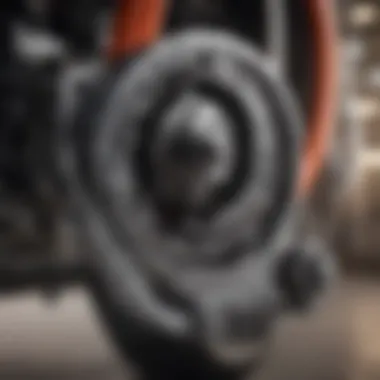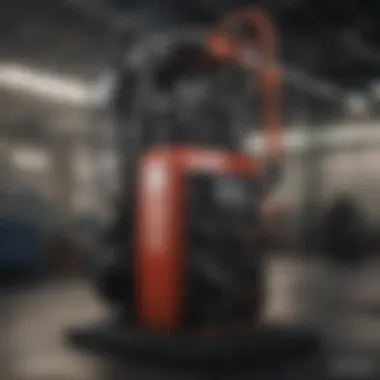Understanding Outdrive Oil Pumps: Maintenance and Selection


Intro
The oil pump might not get the spotlight it deserves, yet its under-the-hood magic plays a crucial role in both automotive and marine contexts. Understanding how an outdrive oil pump operates is more than a technical fascination; it's a gateway to ensuring your vehicle or vessel purrs like a kitten and lasts for years. This guide will walk you through the essentials, from the nitty-gritty of functionality to the dos and don'ts of maintenance, alongside practical tips for selecting the right pump for your needs.
As the modern automotive and boating markets continue to evolve, the importance of effective oil management has become clearer than ever. In an era where environmentally friendly technology and high-performance capabilities are not mutually exclusive, oil pumps straddle the line between efficiency and sustainability. Join us as we delve deeper into the world of outdrive oil pumps, their significance, and how to maintain them.
Current Trends
Overview of Automotive and Boating Markets
The automotive and boating markets have witnessed notable shifts, particularly influenced by consumer demand for higher performance and efficiency. Recently, a growing acknowledgment of environmental impacts has pushed many manufacturers to innovate and adapt. These changes include improved oil management systems, many of which hinge on the dependable function of outdrive oil pumps. In the competitive landscape of boats and cars, integrating high-quality pumps is a must for anyone who wants to keep their machine running smoothly without compromising on eco-friendliness.
Key Drivers Influencing Purchases
- Sustainability Concerns: As the push for greener solutions ramps up, customers are more discerning, seeking products that adhere to environmentally sound practices.
- Technological Advances: Enhanced oil management features, including better filtration and circulation, have made effective pumps more appealing.
- Performance Enhancements: Many buyers nowadays want products that maximize engine performance while minimizing wear and tear. Pumps that adhere to these specifications are highly sought after.
- Informative Resources: The internet has democratized access to information, allowing consumers to make better-informed choices. A click on forums like reddit.com or educational platforms such as britannica.com can arm buyers with critical insights.
With these trends taken into account, it becomes evident that understanding how an outdrive oil pump works is not just for the tech-savvy; it's for every petrolhead and boat enthusiast aiming for longevity in their machines.
"In the world of high-performance machinery, the simplest components often have the most profound impact."
From here, we will explore the intricate mechanisms that underpin the functionality of outdrive oil pumps, as well as how to maintain and select them effectively.
Prolusion to Outdrive Systems
Understanding outdrive systems is crucial for anyone involved in boating or owning an automotive vessel. Outdrives play a pivotal role in transmitting the power from the engine to the propulsion system. They serve as the connection between the propulsion and steering systems, influencing the overall handling and efficiency of a vessel. Comprehending these mechanisms lays the groundwork for grasping the function of the outdrive oil pump, which is central to maintaining these systems.
Outdrive systems can vary significantly based on design, application, and the type of engine used. In many ways, they dictate the performance of the vehicle—whether it’s a high-speed boat zipping across the water or a robust automobile tackling rough terrains. This versatility comes with its own set of considerations. Selecting the correct outdrive system not only ensures optimal operation but also fuels longevity and reliability.
In addition to performance, there’s a sizable maintenance aspect to these systems. The oil pump, which we will later discuss in detail, is at the heart of keeping the outdrive functioning smoothly. Consistent oil flow is essential to ensure components remain lubricated, preventing unnecessary wear and tear. An ineffective or poorly maintained oil pump can quickly lead to significant issues, including overheating and component failures.
The intricacies of outdrive systems necessitate a solid understanding of how they function and how various components interplay. Keeping this context in mind prepares us to dive deeper into the specific mechanisms, highlighting the significance of each component and its contribution to overall performance.
Overview of Outdrive Mechanisms
Outdrive mechanisms are typically comprised of an assembly that includes the drive unit, propeller, and various components that facilitate operation. They can range from simple systems with few moving parts to complex setups featuring advanced technology. The basic function remains the same: transforming rotational energy from the engine into thrust, moving the vessel through water or land.
The gear arrangement inside an outdrive determines both the speed and torque delivered to the propeller. Systems like the MerCruiser or Volvo Penta have carved niches in this marketplace, with designs that favor agility or stability, depending on desired use. A good grasp of the specifics of each system can equip operators with the knowledge needed to choose the right outdrive mechanism for their application.
Importance of Oil Pump in Outdrives
The outdrive oil pump is not just a peripheral component; it's fundamentally important to the operation of the entire outdrive mechanism. This pump circulates oil throughout the system, ensuring that all internal parts are adequately lubricated. Without proper lubrication, friction builds up and can lead to premature failure of critical components. Thus, the oil pump can be seen as the lifeblood of the system.
"Oil is to the engine what blood is to the body. Without it, nothing functions properly."
Moreover, an effective oil pump contributes to cooler operating temperatures. High-performance outdrives often deal with elevated heat, particularly during intense maneuvers or in demanding conditions. The oil helps dissipate this heat, safeguarding the integrity of the system. This critical function underscores the necessity of understanding and maintaining the oil pump.
In summary, a well-maintained outdrive oil pump is not just beneficial; it’s essential for the health of the entire outdrive system. Recognizing this component's role sets a solid foundation for making informed decisions on maintenance and selection, ensuring long-term reliability and performance.
The Role of the Outdrive Oil Pump
The outdrive oil pump serves as a linchpin in outdrive systems, governing the distribution and effectiveness of oil throughout the machinery. Understanding its role is essential for both the health of the equipment and the performance of the vessel or vehicle. In simpler terms, if the oil pump wasn’t doing its job right, there’d be serious damage, and repair costs could skyrocket. The oil pump not only keeps everything lubricated but also cools the components, ensuring they operate smoothly and efficiently.


Functionality and Significance
An outdrive oil pump is crucial for maintaining consistent lubrication in the outdrive assembly, which can help prevent wear and tear in high-friction scenarios. Lack of adequate lubrication can be a recipe for disaster when engines or gears work in harsh conditions. Essentially, a well-functioning oil pump ensures that oil reaches every nook and cranny of the outdrive, which is imperative for maintaining the longevity and reliability of the system.
The oil pump also plays a role in regulating the pressure of the oil. This is key because inadequate pressure can result in oil starvation, while excessive pressure might lead to leaks or burst hoses. Thus, the outdrive oil pump needs to operate within a specific range of performance to keep everything running to perfection.
Types of Oil Pumps Used
Understanding the types of oil pumps available can help one make an informed choice for their outdrive system. Each type has its own strengths, weaknesses, and applications. The main categories include:
Gear Pumps
Gear pumps are typically favored for their simplicity and effectiveness in generating hydraulic pressure. Made up of interlocking gears, they are designed to move oil by trapping it between the gear teeth and pushing it through the outlet. This structure allows for a smooth, consistent flow of oil, making it a reliable choice in various applications.
- Key Characteristic: High efficiency and ability to handle varying viscosities.
- Benefits: Generally durable and relatively maintenance-free.
- Unique Feature: The precise control of flow rate, making them suitable for systems where exact oil delivery is required.
- Drawbacks: Less effective when it comes to low-viscosity oils, which can lead to cavitation in some conditions.
Vane Pumps
Vane pumps are another type often chosen for their variable flow capabilities. They operate by having sliding vanes that move in and out, displacing oil as they rotate. This design allows for not just effective operation under pressure but also provides adaptability in oil delivery.
- Key Characteristic: Ability to adjust flow automatically based on demand.
- Benefits: They work well for both low and high viscosity oils, making them a versatile option.
- Unique Feature: The internal configurations can lead to quieter operations, which might be particularly valuable in marine applications.
- Drawbacks: Vulnerable to wear if debris gets into the system, requiring more frequent maintenance.
Rotary Pumps
Rotary pumps excel in their ability to maintain a constant flow rate, even under varying conditions. Their operation relies on a rotating mechanism that creates suction, drawing oil in and pushing it out with ease.
- Key Characteristic: Constant and steady flow, ideal for systems requiring reliability.
- Benefits: Effective in handling both viscous and non-viscous fluids.
- Unique Feature: Their ability to function effectively over prolonged periods makes them a popular choice in heavy-duty applications.
- Drawbacks: Might not match the quick response time that other types offer, particularly in fluctuating operational demands.
Choosing the right type of oil pump hinges on understanding the specific requirements of your outdrive system. Each has its unique place and knowing these details could prove invaluable in ensuring optimal performance.
Maintenance of Outdrive Oil Pumps
Maintaining the outdrive oil pump is crucial for the longevity and efficiency of both marine and automotive systems. Just like a well-oiled machine, regular attention to this component can yield better performance, reduce the likelihood of costly repairs, and ensure smoother operations. Maintenance isn't merely about keeping the outdrive oil pump running; it's about creating a proactive approach that avails you of peak functionality and reliability.
Routine Checks and Inspections
Routine checks serve as the first line of defense against unexpected failures. It’s essential to stay vigilant. Regular inspections can prevent minor issues from snowballing into major complications. Here’s what to keep an eye on:
- Fluid Levels: Keeping an eye on oil levels is a no-brainer. Low oil can lead to insufficient lubrication and increased wear.
- Leaks: Look for signs of oil leakage, particularly around seals and fittings. A leak can severely impact the performance of your pump.
- Noise: Unusual sounds during operational checks can indicate potential problems. Pay attention to whining or grinding noises—they're usually signals that something is awry.
Taking these simple steps can save considerable time and money down the line.
Changing Oil and Filters
Changing oil and filters is another key aspect of pump maintenance. This task shouldn’t be considered optional. Fresh oil plays a pivotal role in reducing friction and dissipating heat throughout the system. Here’s how you can approach this task:
- Scheduled Changes: Follow the manufacturer’s recommendations for oil change intervals. For many, this is often every 100 hours of operation.
- Use the Right Products: Selecting the correct oil type is critical—synthetic blends often offer better protection than conventional oils.
- Filter Maintenance: Don’t forget about the filters. A clean filter can keep contaminants from causing damage. Replace it while you’re at it.
Failing to change the oil regularly can cause sediment buildup, leading to decreased efficiency or even pump failure.
Signs of Wear and Tear


Understanding the symptoms of wear and tear can help you catch problems before they escalate. Don't ignore the signs. If you notice any of the following, it's time to investigate:
- Increased Vibration: Excessive vibrations during operation could indicate problems with bearings or impellers.
- Discoloration of Oil: Dark or milky oil can be a sign of contamination or water intrusion. Stay alert!
- Reduced Performance: If your system isn’t functioning as it should, check the pump. A decline in performance might signal that the oil pump is struggling.
Recognizing these signs early can extend the life of the outdrive oil pump and improve overall system reliability.
Troubleshooting Outdrive Oil Pumps
Troubleshooting outdrive oil pumps is a vital part of keeping marine and automotive systems functioning smoothly. These pumps are the unsung heroes, quietly ensuring oil circulates effectively, preventing breakdowns and prolonging the lifespan of your equipment. Identifying issues early can save you a heap of trouble and expenses down the road.
Common Operational Issues
Understanding common operational issues can make all the difference in maintaining an effective outdrive. These problems can range from minor annoyances to major failures. Some frequent culprits include:
- Oil Leaks: Leaks can occur for several reasons, such as improper seals or wear and tear on components. If oil is pooling around the pump, it's a clear sign something’s amiss.
- Low Oil Pressure: If the oil pressure gauge shows low readings, it may indicate a clogged filter or inadequate oil supply. This is like warning bells ringing in your engine.
- Noisy Operation: Unusual sounds, such as grinding or whining, usually hint at internal damage or insufficient lubrication. Think of it as your pump's way of crying for help.
- Overheating: An overheating pump may signal a blockage or a malfunctioning thermostat. When pumps run too hot, they can fail quickly, causing extensive damage.
Diagnostic Techniques
To aid in troubleshooting, employing effective diagnostic techniques is essential. Here are key approaches that can help you identify what’s gone wrong:
- Visual Inspection: A thorough examination can reveal many issues—look for oil stains, physical damage, and the overall cleanliness of the pump.
- Pressure Testing: By using a pressure gauge, you can accurately measure the oil pressure, helping to pinpoint leaks or pump failures.
- Sound Analysis: Listening closely to the pump can provide insight. A well-functioning pump should operate quietly while erratic noises can indicate internal problems.
- Fluid Analysis: An oil analysis can reveal contamination levels and degradation of the oil. This method can be surprisingly revealing, often highlighting issues that are not yet apparent.
When to Seek Professional Help
Sometimes, diagnosing and fixing issues with an outdrive oil pump can stretch beyond your capabilities. Knowing when to call in the pros is crucial:
- Persistent Problems: If you’ve attempted simple fixes such as changing the oil or replacing filters but the issues continue, it might be time for a professional evaluation.
- Complex Repairs Needed: Major repairs, especially those requiring parts to be removed or replaced, should usually be handled by someone experienced.
- Uncertainty About Diagnosis: If you’re unsure what’s wrong or how to fix it, getting a second opinion from a technician can save both time and money.
- Warranty Considerations: If your outdrive pump is still under warranty, tampering with it might void that coverage. Professionals usually have systems in place to maintain those warranties.
"When in doubt, get it checked out. Trying to fix a major problem yourself can lead to bigger headaches down the line."
Navigating issues with outdrive oil pumps doesn’t have to be a daunting task. With a solid understanding of common problems, diagnostic techniques, and knowing when to seek help, you can keep your systems running smoothly and efficiently.
Selecting the Right Outdrive Oil Pump
Choosing the correct outdrive oil pump is paramount for ensuring the smooth operation of your marine or automotive systems. It can seem like a daunting task at first glance, but taking a closer look reveals that several elements guide this important decision. Selecting the right pump is a critical junction where performance, efficiency, and longevity intersect, making it the linchpin for effective oil management.
Whether you're a weekend warrior out on a boat or an avid automotive enthusiast, understanding what sets each pump apart can make a world of difference.
Factors to Consider
Compatibility with Engine Type
When it comes to pumps, the engine type is the name of the game. Each engine has specific requirements, and the pump needs to match those to function properly. Compatibility is essential because using a pump designed for a different setup can lead to inefficiencies or, worse, mechanical failures.
The key characteristic here isn't just about fitting; it’s about ensuring optimal performance. Think about it: a pump that's designed to work seamlessly with an engine will move oil more effectively, ensuring vital components receive adequate lubrication. Imagine you’ve got a robust V8 engine but pair it with a pump designed for a four-cylinder. The resulting mismatch can lead to all sorts of headaches, including overheating and increased wear on engine parts.
A unique feature associated with compatibility is the installation process. A pump that fits like a glove typically means hassle-free installation, which is a big plus for DIY enthusiasts. However, if compatibility is overlooked, it can result in complex installation and costly repairs in the long run.
Oil Capacity and Flow Rates
Next up, we have oil capacity and flow rates: two sides of the same coin. Understanding the oil capacity your engine requires is crucial for selecting the right pump. This factor directly affects the engine’s ability to maintain lubrication and dissipate heat, ultimately influencing performance and longevity. You wouldn’t fill a sports car with regular unleaded gas—similarly, putting a low-capacity pump in a high-performance engine could cripple its effectiveness.


The salient point here is flow rate, which refers to the volume of oil circulated within a specified time frame. A pump with an inadequate flow rate can lead to inadequate lubrication, putting stress on components.
An advantage of observing proper oil capacity and flow rates is the prevention of engine wear and tear. Selecting a pump that adheres to your engine's specifications pays dividends in the long run, preserving both performance and longevity.
Durability and Performance Standards
Let’s not forget about durability and performance standards. When selecting a pump, you want something that won’t give up the ghost after a few uses. Pumps that can withstand high pressures, resist corrosion, and function effectively in various temperatures are worth their weight in gold.
A high quality pump should boast performance standards that meet or exceed industry norms. This characteristic not only ensures that you’re getting a reliable product but also one that can handle the demands of your engine under duress.
One unique feature here is the materials used in construction. For instance, pumps made from stainless steel or advanced composites typically offer better longevity and resistance to damage. The drawback? They can be pricier compared to standard options, but paying a bit more upfront might save you from larger repair costs later.
Brand Comparisons
In an ever-competitive marketplace, understanding brand differences can further enlighten your selection. Each brand may offer various models with distinct features, performance metrics, and reliability. Comparing brands allows an informed choice that aligns closely with your specific needs and can significantly affect your operational efficiency.
Thus, equipping yourself with the right information isn’t just a luxury—it’s your best bet for ensuring your entire system runs like a well-oiled machine. Remember, in the world of machinery, choosing wisely today can save a heap of trouble tomorrow.
Future Trends in Oil Pump Technology
The evolution of outdrive oil pumps is akin to fitting a square peg into a round hole; it’s all about innovation and adaptation. As the demand for better performance, efficiency, and sustainability rises in the marine and automotive industries, future trends in oil pump technology are crucial. They not only outline where the industry is headed but also showcase how advancements can lead to enhanced operation and increased longevity for these essential components.
Advancements in Pump Design
Modern engineering has shifted gears with the introduction of more efficient oil pump designs. Traditional options often faced limitations in flow rates and pressure consistency. In contrast, newer designs employ advanced materials like composites and stronger alloys which allow for lighter, more durable pumps. Recent innovations include the implementation of computer-aided design (CAD) tools to model fluid dynamics more accurately, resulting in pumps that minimize friction losses while maximizing oil flow.
- Benefits of Advancements:
- Improved fuel efficiency for vessels and vehicles.
- Extended service intervals, saving time and money on maintenance.
- Enhanced durability, reducing the chances of malfunction during operation.
Furthermore, the rise of modular designs allows for easier upgrades and repairs, which is a boon for both consumers and manufacturers. Swapping out a part instead of replacing the entire unit aligns well with the modern focus on sustainability, lowering waste and resource consumption.
Impact of Electric and Hybrid Technologies
As electric and hybrid systems gain traction, oil pump technology must too, adapt. Unlike traditional gas engines, electric motors offer variable speeds that demand an equally versatile oil pump system. These systems can experience lower heat output, but they do require precise lubrication management to optimize performance. The transition is multi-faceted, with notable implications for outdrive oil pumps:
- On-demand Oil Pumps: These pumps can operate only when needed, enhancing energy efficiency and reducing excess wear on parts.
- Integration with Digital Systems: Many modern outdrives use sensors and digital interfaces to monitor and adjust oil flow dynamically, leading to better engine health.
- Reduced Environmental Impact: By managing oil flow precisely, emissions decrease, aligning with worldwide efforts toward sustainability.
"Electric and hybrid technologies challenge pump designers to innovate—paving the way for smarter, more efficient lubrication solutions that reduce our carbon footprint while enhancing performance."
The future of outdrive oil pumps is not merely about keeping pace with change; it’s about redefining efficiency and operational effectiveness. It’s essential for users and enthusiasts alike to stay informed and prepare for these evolving technologies that promise to enhance usability and reduce environmental impact as we sail—or drive—into the future.
End
The significance of the outdrive oil pump cannot be overstated. It acts as the linchpin in maintaining the engine’s well-being by ensuring optimal oil circulation. This not only enhances the overall performance of the engine but also contributes to its longevity. Modern advancements in oil pump technology have further refined the performance metrics, allowing for the integration of more efficient systems that embrace eco-friendly practices.
Summary of Key Insights
In our examination of outdrive oil pumps, several critical aspects stood out:
- Essential Functionality: The pump plays a vital role in circulating oil, which lubricates crucial components of the outdrive system, preventing wear and overheating.
- Maintenance Practices: Regular checks, oil changes, and the vigilance against signs of wear can significantly prolong the life of the pump. Paying attention to these details can save boat owners considerable money in the long run.
- Troubleshooting Techniques: Recognizing common issues early on ensures that minor problems do not escalate into major failures. Familiarity with diagnostic practices can empower users to take proactive steps.
- Selection Criteria: Factors like compatibility with engine types and performance standards are paramount. A well-matched oil pump can enhance efficiency and reliability.
This article has outlined these key elements, providing a rounded perspective that aids both novices and seasoned enthusiasts in navigating outdrive oil management.
Looking Ahead in Outdrive Oil Management
Looking to the horizon, the future of oil pump technology promises to be exciting. With ongoing research into electric and hybrid technologies, it’s clear that the landscape is shifting. These innovations could lead to pumps that not only operate more efficiently but also reduce environmental footprints. The integration of smart technologies is likely to enable real-time monitoring of oil conditions, further empowering users to maintain optimal performance.
As we continue to evolve in our understanding of marine and automotive systems, the importance of the outdrive oil pump will remain a focal point. Its role is poised to grow, adapting to advancements while continuing to deliver on its promise of exceptional performance and reliability. The next generation of outdrive systems will depend on this delicate interplay of technology, maintenance practices, and informed choices, ensuring a smoother ride for all.







